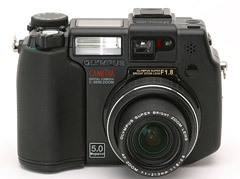
I keep telling people that capture devices are so much better these days, and as a result, paying attention to correct exposure and white balance pays big dividends in post production. But I hadn't really tested my theory until the other day when I pulled out an older (Nov. 2002) Olympus C-5050 Zoom, set it to Raw mode at ISO 100, and took a series of pictures. I then made A4 prints and compared them to images I'm currently capturing with my pocket-sized Canon PowerShot SD700 IS in simple Jpeg mode. The difference in quality was stunning. The compact Canon in Jpeg mode blew away the sophisticated Olympus in Raw. No knock whatsoever on the Olympus... it's just the difference that 3 years can make during our evolution in digital photography. (And what a shame... I love that Olympus camera!)
This podcast extends that discussion and even includes some remarks about film cameras, workflow, and how to best take advantage of today's excellent capture devices.
Dec. Photo Assignment
I also talk about the December photo assignment, "Pool of Light." I originally got the idea for this assignment by looking at some of Steve Simon's existing light pictures when he composed the main subject in a pool of light and let everything else live in the shadows. I think this is very effective.
Listen to the Podcast
Now that I've piqued your curiosity, it's time to listen to today's audio show titled, "Capture." You can download the podcast here (31 minutes).
Technorati Tags: digital photography, podcast, The Digital Story
Sponsor Note...
Add Magic to Your Slideshows -- FotoMagico presentations are so amazing that your audience will be asking how you did it.












Could not agree more about good capture techniques. I shoot 98% of the time in RAW+JPG. I use the JPG for quick review, thumbnails and client show-n-tell. I use the RAW for final batch output. The ability to shoot good focus, good exposure, good white balance, good framing and such in-camera is a good idea to get used to doing. The workflow on the backend is much quicker. For me, I end up batching sequences so they match the overall look of the day and tweak a subset of images that were in tricky lighting so they match. Will often expose a shot "properly" but use the RAW to keep the shadows and the highlights in tough event locations. Good capture is key to workflow instead of workslow. ;-)
Fine art is where I break this rule, but event photography is important to get as right as possible the first time. Especially with brides.
I too have Canon 5D and an Olympus C-5050. What disappointment! I've got the 5050 after owning a c-4000 and having a great experience with that. When it broke down I upgraded to the 5050 only to be horrified by all the things you say about it! The picture quality of this camera is inferior to its predecessors, so comparing today cameras against it might be a bit unfair.
It might not be as unfair as you think comparing the C-5050 to current cameras. When I was researching this piece, I went back and read the most popular reviews of this camera, and all of them recommended it. I shot a number of jobs with it that turned out well.
The point is, that today's cameras are vastly improved. Even my Canon G2, which provided better images than the C-5050, can't compete with the cameras I have now. As I said, too bad too, because I really like the G2 and the C-5050.
Well, I will not argue anymore. I was just surprised and angry to see that after spending 700 dollars (after reading glorious reviews and seeing the 2003 or 2004 Camera of the year in PC World go to this camera) that this camera took noisier and softer pictures than the Olympus C-4000, a 4 MP camera.
No doubt that today's cameras are better then the old ones, a phenomenon that may not necessarily be true in film (besides the electronic focus and better meters).